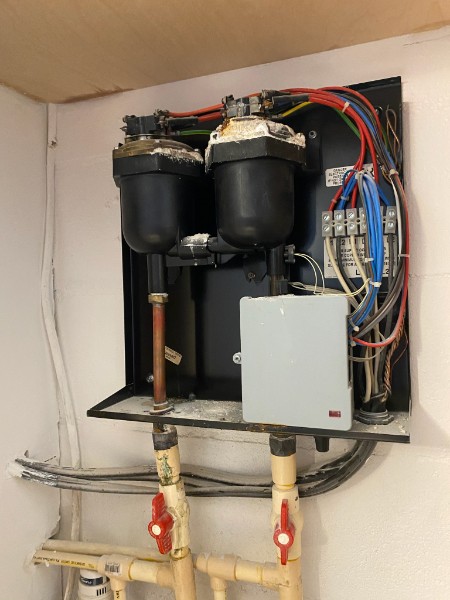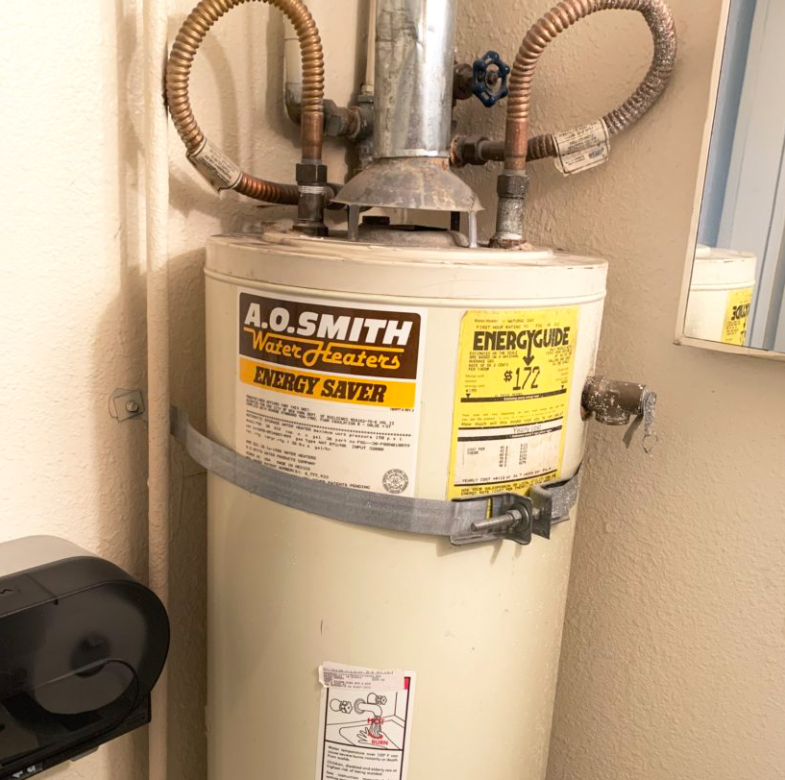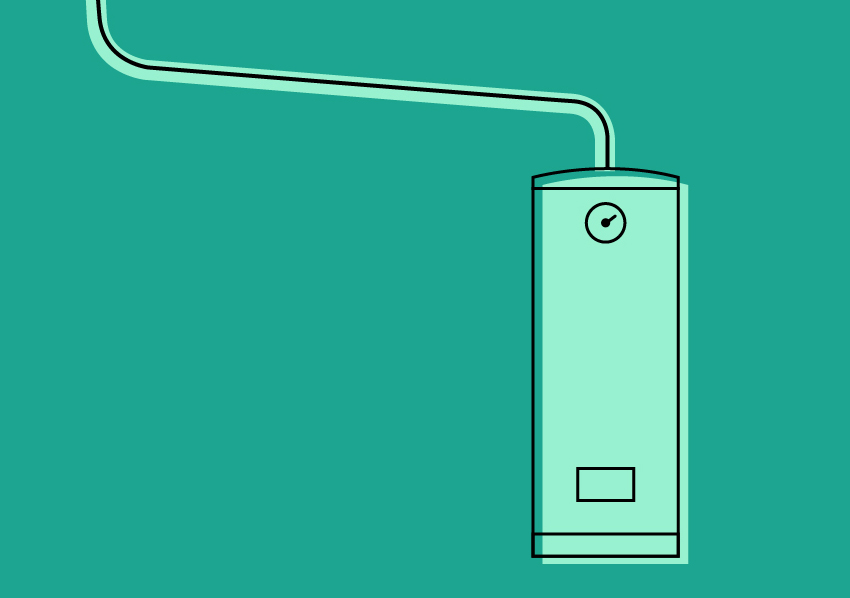Upgrading A Water Heater: Heat Pump, Solar, Or On Demand?
By: Scott Cooney | cleantechnica.com
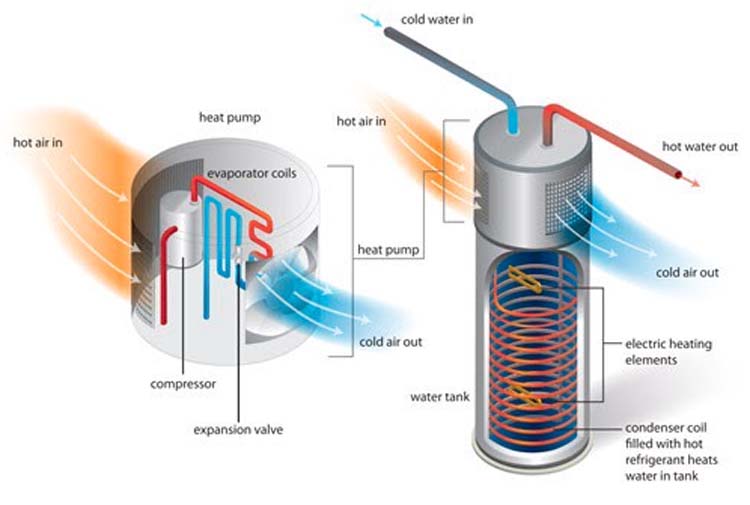
Image Credit: CleanTechnica.com | Heat Pump Water Heater Diagram, courtesy of Energy Star
The water heater is one of the bigger users of energy in the home, making that old heater you’ve got a great candidate for an upgrade. The question is, upgrade to what? There are solar water heaters that can use zero energy, heat pumps that use a lot less energy than traditional water heaters, and tankless water heaters that create hot water “on demand” only when needed. Each has some benefits and drawbacks. In this article, I’ll dive into the tech, the finances, and the pros and cons of each, so that you can make the best decision.
Traditional Water Heaters
Most water heaters still in use today are either electric resistance (ER) or gas. ER water heaters use electricity to directly heat water. In both cases, water comes out of the ground, aquifer, reservoir, or other municipal water source you have, and is then heated from whatever temperature that is to 120°F or whatever you have your water heater set at. This is just plain silly and very, very inefficient.
Groundwater or water coming out of the bottom of a reservoir can be absolutely frigid. So you’re looking at a delta (change in temp) of as much as 80-90 degrees.
Heat Pump Water Heaters
Heat pump water heaters (HPWH) eliminate a lot of that delta. HPWH do not generate heat directly like ER, instead heat is captured from one of three sources: air-to-air (most commonly known as air source water heaters or ASWH), water source, and geothermal. Heat is absorbed from the source and used to heat the water. It’s basically a refrigerator or AC in reverse.
According to Energy Star, the requirements for HPWH are pretty simple: it needs to be put in a place where the temp stays between 40 and 90 F year round (so, unless you live where it stays in that range, just put the HPWH inside the building), air flow (a room of 100 square feet is sufficient, or, lacking that, a space that can be ducted), needs a drain of some sort (floor, utility sink, sump pump, etc), and clearance (the more people in the home, the bigger the tank will need to be).
Many HPWH have hybrid options, which means that during times of excessive use, they can switch to being a more traditional electric resistance water heater. Heat pump water heaters are 7x more efficient than gas, and 3.5x more efficient than ER.
Consider the Energy Guide listings for equivalent Rheem 45 gallon water heaters:
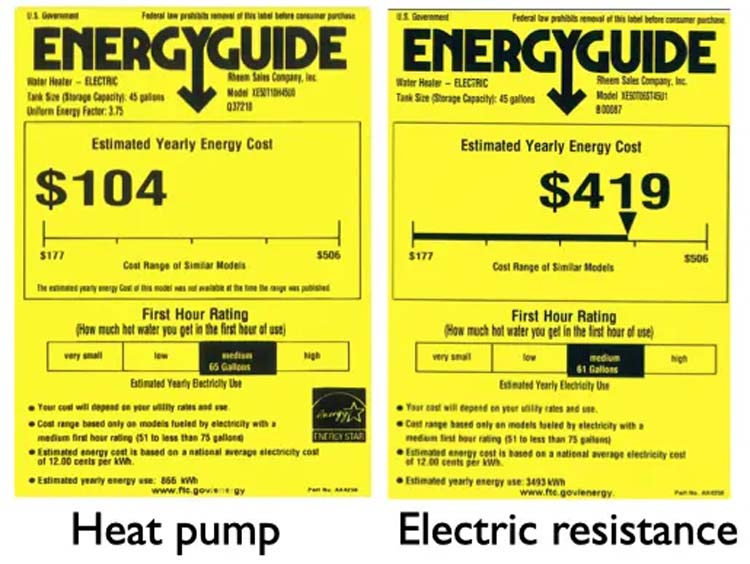
Image Credit: CleanTechnica.com
Solar Water Heaters
Solar water heaters (SWH) are typically direct heating instruments. Water is pumped through some panels on your roof, which are designed to collect heat from the sun, concentrate it in the pipes through which the water is running, and heat the water up to the desired level (e.g., 120°), then pump it down into your hot water tank. This direct heat eliminates the use of electricity except for the minimal amount needed to pump water around.
What happens at night, or if it’s cloudy? Most solar water heaters have an option to have an electrical backup, so that when it’s cloudy, the backup will heat the water. But the goal is to use the sun as much as possible, so SWH are typically fit with timers to ensure 24-hour access to hot water. In practicality, that means you might have an electrical backup that kicks on in the early AM hours before people wake up, to top off the temp in the tank. Similarly, they might kick on in the evening, between 7-9 PM, to similarly top off the heat for those showering before bed.
The nice part about SWH is that you can choose – if you’re ok with occasionally being out of hot water, you can actually deactivate the electrical backup and just rely entirely on free hot water from the sun.
On Demand Water Heaters
As the name implies, “on demand” water heaters (ODWH) create the hot water only when it’s needed, eliminating the need to store heated water. So when you turn on the hot water valve, the heater kicks on and starts rapidly heating, so that within a few seconds you’ll have hot water coming out of your showerhead. The biggest savings this creates is in the elimination of the need to keep water hot. The tank you have holding hot water is constantly losing heat, even if properly insulated. Thus, a tank water heater (any kind) will continuously need to replenish and/or re-heat the water in the tank. But otherwise, tankless water heaters are not the most efficient at creating hot water.
So Which To Choose When Upgrading Your Water Heater?
Now that you understand the basic tech of your options in water heating, it’s time to decide what to go with. Here are some basic concepts to help you decide.
First, the number of people is important. Heat pumps tend to take a little more time to heat water, so for homes with a lot of folks, they might not be the best option. Typically, 3-4 people using hot water from a heat pump would be the most you’d want to do to ensure completely uninterrupted service. You can get larger tanks, but the heating process is still slower in heat pumps than other water heaters. Solar water heaters can provide for many more people, as they have both the limitless power of the sun and an electrical backup, and can accommodate 120-gallon tanks. ODWH can obviously also do the job for higher numbers of people. The caveat, of course, is that if your HPWH has a hybrid option (as mentioned above, where it can switch to being a pure ER water heater as needs arise), then it will do the job for the amount of water needed, but of course, that will make the energy use profile go up in a corresponding way. So if it’s 3-4 people *usually* in the home, with the occasional guests making it heavier demand for hot water, then HPWH is still the best bet. But if you have 6 people in the home, regularly using hot water, then HPWH likely will not deliver as much savings as a SWH, which, with a large tank, could more readily provide free hot water for 7-8 people.
Second, the use profile is important. If you’re away a lot (i.e., the home is vacant), then an ODWH makes perfect sense. Otherwise, SWH or HPWH are better options. If people primarily use hot water during the day, SWH is likely the best option.
Third, let’s consider the budget. SWH are the most expensive up-front of all the options listed here. They do tend to pay for themselves well over time, especially if the use profile and number of people are well aligned. HPWH are far less expensive, often close to price parity with the ER and gas after local and federal rebates. SWH and HPWH will tend to have rebates available in most places, whereas ODWH typically don’t.
Last, how do you decide how to time your water heater replacement? If your current system is 8+ years old, if it has any leaks, or performance issues (like running out of hot water regularly), it’s time to upgrade. If you’re not sure, check the nameplate on your current water heater, which should say the manufacture date. If the system is newer than 8 years, it’s perhaps not time, but if you’re ready, the rebates are there, and you like the idea of reducing your impact, it may still be a great idea. The return on investment is good in most places, and with rebates/incentives, a HPWH could save enough every month to pay for itself in just a couple of years or less. SWH tend to take a little longer to pay for themselves. If you don’t mind the occasional interruption in hot water service, though, SWH can entirely eliminate the utility cost for water heating.
If you have a gas appliance, and it’s the last gas in your house, changing over asap is the best move. This is for several reasons. One, having gas in your house seems just silly — gas lines can leak and cause indoor air quality problems, as well as cause fire hazards to become more complicated. Gas is primarily obtained via fracking, an entirely unsustainable and chemically intensive process. And gas is most often from fossils, whereas going SWH, HPWH, or ODWH means you can use renewable energy to power your hot water heater. The other bonus of eliminating gas is the hookup fee. Just to have gas coming to your house, your gas utility is charging you anywhere from $10 to $20 per month, before you even get one therm of gas.
This article was cross posted from cleantechnica.com. Original article could be read here.
Original post here: Upgrading A Water Heater: Heat Pump, Solar, Or On Demand?

